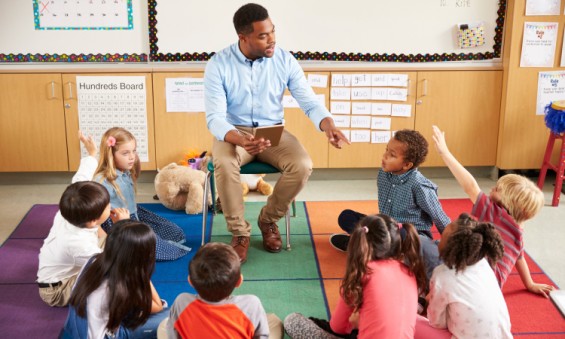
Too many teachers in the US are struggling to get by. Here’s what we can do to help.
We entrust teachers with the world’s most important job: educating our kids, says researcher and dean Gregg Garn. So why aren’t we paying and treating them in a way that shows they’re valued?
In 1892, a man named David Ross Boyd boarded a train and traveled to Oklahoma for the first time. He was showing up for work — he’d taken the job, sight unseen, to be the first president of the University of Oklahoma. When he arrived in Norman, where the school was to be located, he faced an incredible challenge. He had no faculty and no students; he didn’t have a single building where he could teach. At that time, Oklahoma was a territory, so he didn’t have any state government support behind him. However, he wasn’t deterred by the situation. He saw it as an opportunity to create something special.
Today we educators face a different but similarly monumental challenge. People nationwide are asking, “What kinds of schools and teachers are we getting in return for our school tax dollars?” And teachers are wondering, “How can I possibly raise a family on my salary?”
Teacher salaries have not kept pace with those in other occupations. In 1994, the average college graduate with an education degree earned 2 percent less than the average college graduate. By 2015, that gap had grown, with people getting education degrees making 12 percent less. Let me put that into perspective. In 30 states, if I’m a mid-career teacher and the single breadwinner in a family with two kids and a spouse, my children qualify for free or reduced-price lunch at the school where I teach; they also qualify for government health care. Teacher salaries have bottomed out. While it’s true that people don’t go into the profession to get rich, it’s alarming and disheartening to realize that the paycheck is so low that your kids will qualify for free or reduced lunch in most of the country.
Here are a few of the fundamental questions that teachers today are struggling to answer. Should they be able to afford a house in the school district where they teach? Should they need to work a second job so they can cover their bills at the end of the month? Should they be able to save enough so they can send their children to college without huge amounts of debt?
It’s not only compensation levels that have gone down — it’s also the perception of educators. If you asked people 20 or 30 years ago, “What do you think of teachers?”, I’d argue that many would talk about how teachers were the respected pillars of the community, and they had a huge impact on those around them. Now teachers are perceived as being part of the problem with the education system in the US. They’re seen as stuck in the status quo, not willing to grow and move forward. Increasingly, teaching is seen as being closer to a service industry job than a profession, and this has devastating consequences on attracting the talented people we need to strengthen our schools and communities.
According to 2016 data from the National Center for Education, my home state of Oklahoma ranks near the bottom in terms of teacher salaries. That’s right: out of 50 states, we’re in 49th place. If you look at total compensation and add in health-care and retirement benefits, Oklahoma goes up to 48. However, I’m afraid that by the time the 2018 data catches up, we’ll be dead last. To give you an example, in 80 percent of the districts in my state, a person with a doctorate in education and 25 years or more of teaching experience makes just $46,000 a year, according to the state salary scale.
Think about that salary for a second. What do you think that does to the number of great people going into the profession? We’re experiencing a teacher shortage in Oklahoma, and the system has responded with a phenomenon called “emergency certifications.” People with emergency certifications are permitted to teach students, even though they are not yet certified to do so. They’re only about as qualified as a substitute teacher. Can you recall a transformational substitute teacher from your own life? I didn’t think so. And yet we had almost 2,000 EC teachers in the fall of 2017. In Oklahoma, most of the emergency certs are working in elementary education, which means unprepared folks are responsible for teaching our children the fundamentals of reading, math and science. This doesn’t add up to a good future for those 50,000 kids in their classrooms.
I know we all want to live in stable, thriving communities. A thriving community is connected to a strong school system, and a strong school system depends on good teachers — professionals who have deep knowledge about the subject they teach, a scientific understanding of how people learn, and an ability to manage and motivate kids in a classroom. Great teachers are also important for our democracy. People need to be able to read and think in order to be active, thoughtful participants in a democratic society.
I’ve been studying education policy for 20 years, and I’ve come up with a few ideas for how we can attract and retain smart, caring people in the teaching profession. However, I want to stress that there is no single recipe for success that will fit every single community, because every community is different, with its own strengths, resources and connections. Instead, we need a buffet of different ideas that communities can draw from and adjust to their needs. I also think we can’t expect teachers to solve these complex problems on their own. We need public-private partnerships, people from a variety of perspective coming together to tackle challenges. Finally, we must do a better job of trying out new ideas — and then of spreading what works and pivoting away from what doesn’t. “We’ve always done it this way” cannot be our answer to problems.
The first idea is about reducing the student-loan debt that burdens many teachers after going to graduate school. At the Rainbolt College of Education, where I serve as dean, we have a program called Debt-Free Teachers. It’s a simple concept: you graduate from the College of Education, you become a teacher in a high-need area in Oklahoma, and we’ll forgive up to $5,000 of your higher-ed investment each year for four years (and up to $20,000). In those four years, people put down roots, and they end up staying in the state and becoming our best teachers. We have 60 participants in this program, and we are helping the University of Central Oklahoma design a similar initiative. Communities thinking about competitive ways to attract and retain great teachers could do a variation on this program.
The second idea is about assisting teachers with housing. A hundred years ago in Oklahoma and other states, educators received a place to live as part of their compensation. What would that look like in the 21st century? How can we connect teachers in our communities to houses? We have a pilot program at the College in which 17 students are participating in a United Way financial boot camp. When they graduate, and as long they have a 660 credit score, they qualify for the Oklahoma Housing Finance Authorities Dream Home Act. They’re eligible to buy a house that costs up to $250,000, and they’re required to put down only a 3 to 5 percent down payment. Young teachers can immediately begin building their personal wealth by investing in a house. What other possible variations could exist? Could a community foundation provide a down payment match to help recruit a teacher into that community? What if cities where houses are frequently condemned started a Habitat for Humanity-type program where volunteers fixed up the houses for great teachers? There are all kinds of ideas to imagine, but the fundamental concept is that communities need to think of creative ways to lure teachers and encourage them to stay.
The third idea is about creating what we call community schools. In the field of education policy, we can get so focused on complex concepts that we miss this very simple idea: if a kid’s basic needs are not being met, how can you can address their academic needs? If a child is being abused, chronically hungry, or dealing with mental health or physical health issues, you can’t give them a sheet of algebra homework and expect them to learn. What if we thought about schools as a hub that connected professionals to the kids, instead of it being the responsibility of the kid or the family to find those people in their communities? We have a study now where 36 community schools in the Tulsa area are doing this. It’s early on in the research, but we’ve seen some really amazing outcomes. Teacher satisfaction has risen, because teachers actually get to teach — they don’t have to be the parent, the physician and the social worker. Another result that’s surprised us is a dramatic decrease in student mobility. Many families with kids live on the edge — they’re constantly moving around when they can’t make rent. In our study, we’ve seen that even when families are pushed out of the place they’re living, they’re making the conscious decision to make sure their kid remains in the boundaries of their elementary school. That’s totally different than what we see happening with lots of other families whose children bounce across multiple schools in multiple districts in a single year. It has a tragic impact on a kid’s academic performance when a teacher doesn’t have the sustained ability to work with them.
While I don’t want our federal and state governments to abdicate their responsibility in providing our children with a good education, I’ve become increasingly convinced that we’ll find the solutions in our communities. It will take people connecting with the schools and teachers in their areas that will allow them to thrive. So, get involved in your schools. Visit them, get a sense of what their opportunities and challenges are, and then jump in and start to solve them.
This piece was adapted from talk given at a TEDxOU event.
Watch the entire talk here:
ABOUT THE AUTHOR
Gregg Garn is the Dean of the Jeannine Rainbolt College of Education as well as the executive director of the K20 Center for Educational and Community Renewal. He also holds the Linda Clarke Anderson Presidential Professorship and serves as professor of Educational Leadership and Policy Studies. His research focuses on school choice, policy development and implementation and the politics of education. This piece was adapted for TED-Ed from this Ideas article.
Art credit: iStock




